The Houston Astros beat the Philadelphia Phillies in the 2022 World Series, four games to two.
I rooted for the Phillies, partially because they were the underdog, but mostly because of the cheating scandal that tainted the Astros’ 2017 World Series win.
This time, no cheating was necessary. The Astros did it with a superb pitching staff and a dangerous lineup.
Over the last six years, Houston has been in the postseason every year, won four pennants and now two World Series. That’s almost dynasty talk (with a 2017 asterisk).
I’ll cover the players in the game highlights, but first a little love for Dusty Baker and a shoutout to Central Missouri Mule Jim Crane.
Congratulations to Astros Manager Dusty Baker – Hall of Fame Bound: Dusty Baker became the manager of the Astros in 2020. Although many could not forgive the Astros because of the sign-stealing scandal, there was universal sentiment that Dusty was a good choice for the beleaguered team that was still winning but very unpopular outside of Texas. Baker is a revered man in the baseball community, and his presence with the team softened some of the rancor for the Astros.
As the Astros made their run in this 2022 postseason, there was still the nagging thought of 2017. But there was one silver lining noted by many sportswriters – the respected Baker could get his first managerial World Series win. He had won 2093 games and led five different teams to division titles. But he had not taken a team all the way – until this year. And the timing was good for another reason – in a year when no African-American players were on either roster, Dusty was a reminder of African-American contributions to the game. He is also the oldest manager to win a World Series (73).
One of the best ways to appreciate Dusty Baker is to listen to his 2021 interview with President Bob Kendrick of the Negro Leagues Baseball Museum. There are stories of Satchel Paige, Hank Aaron, the Civil Rights era and more. You can get a feel of the interview with this short clip about Satchel’s “throat cutter” pitch and then come back later to listen to the full podcast. It’s a baseball delight. Below, Dusty and Bob.

Congratulations to Astros Owner Jim Crane – A Central Missouri Mule: I got a heads-up on this item from my friend Tom Wyrsch, a proud alumnus of Central Missouri State University in Warrensburg (now called the University of Central Missouri). He told me that Astros owner Jim Crane attended the college and played for its baseball team (the Mules). Crane is also a long-time major donor to the school.
Crane grew up in suburban St. Louis and went to college at Central Missouri where he pitched for the Mules. When Crane’s father died after his freshman year, he considered dropping out of college. But his coach, Robert Tomkins, drove to St. Louis and talked him into returning to school. Crane did not forget the school or the gesture by his coach. One of his many gifts to the school came in 1998 when he was the largest donor in a $1.2 million upgrade of the baseball stadium which was already named the James R. Crane Stadium. As part of the donation, he asked that the stadium be renamed. It became Crane Stadium at Tomkins Field.
Crane was a standout player for Central Missouri. From 1973 to 1976, he went 21-8 with an ERA of 2.42. He holds the school’s single-game strikeout record of 18, accomplished in the College World Series. In 2014, his number was retired:
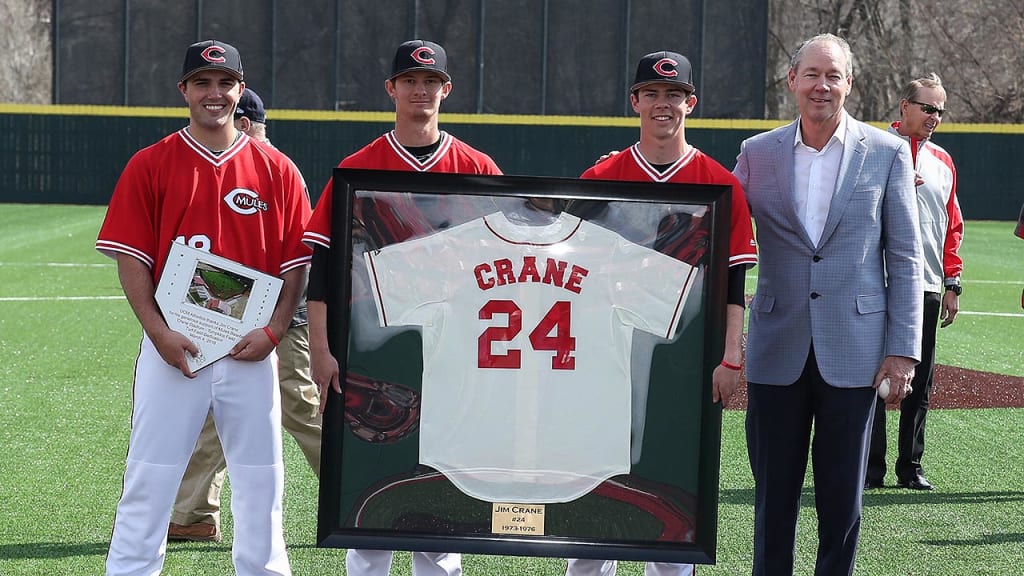
Go Mules.
2022 World Series – Royals Fandom: For me, Game 1 of the 2022 World Series was all about the Kansas City Royals. In 2014, the Royals won the Wild Card game over Oakland, swept the ALDS over the Angels (3 wins) and swept the ALCS over the Orioles (4 wins). Eight straight postseason wins. An MLB record. The streak ended when they lost Game 1 to the Giants in the World Series.
As this 2022 Series got underway, the Houston Astros had a shot at tying that postseason record in Game 1. They had swept the ALDS over the Mariners (3 wins) and swept the ALCS over the Yankees (4 wins). A win in Game 1 would tie the Royals and potentially lead to breaking the record in Game 2.

But it was not to be. Houston lost Game 1 and – HOORAY – the Royals still hold the record.
Game 1 – Phillies Win 6-5: Houston’s Justin Verlander may win the AL Cy Young Award this year. And he pitched like that as he mowed down his first nine batters. Meanwhile, the Astros offense scored five runs to make it 5-0 after three innings. Houston was being dominant, consistent with the expectation of most experts and gambling sites.
But Verlander faltered and gave up five runs in the next two innings to deadlock the game at 5-5. From the 6th to the 9th inning, neither team scored although Houston threatened in the 9th. With two out, Jose Altuve was on second. Jeremy Pena looped the ball into right field, and it looked like a hit that would score Altuve for the win. But Nick Castellanos made a great sliding catch (below) to send the game into extra innings.
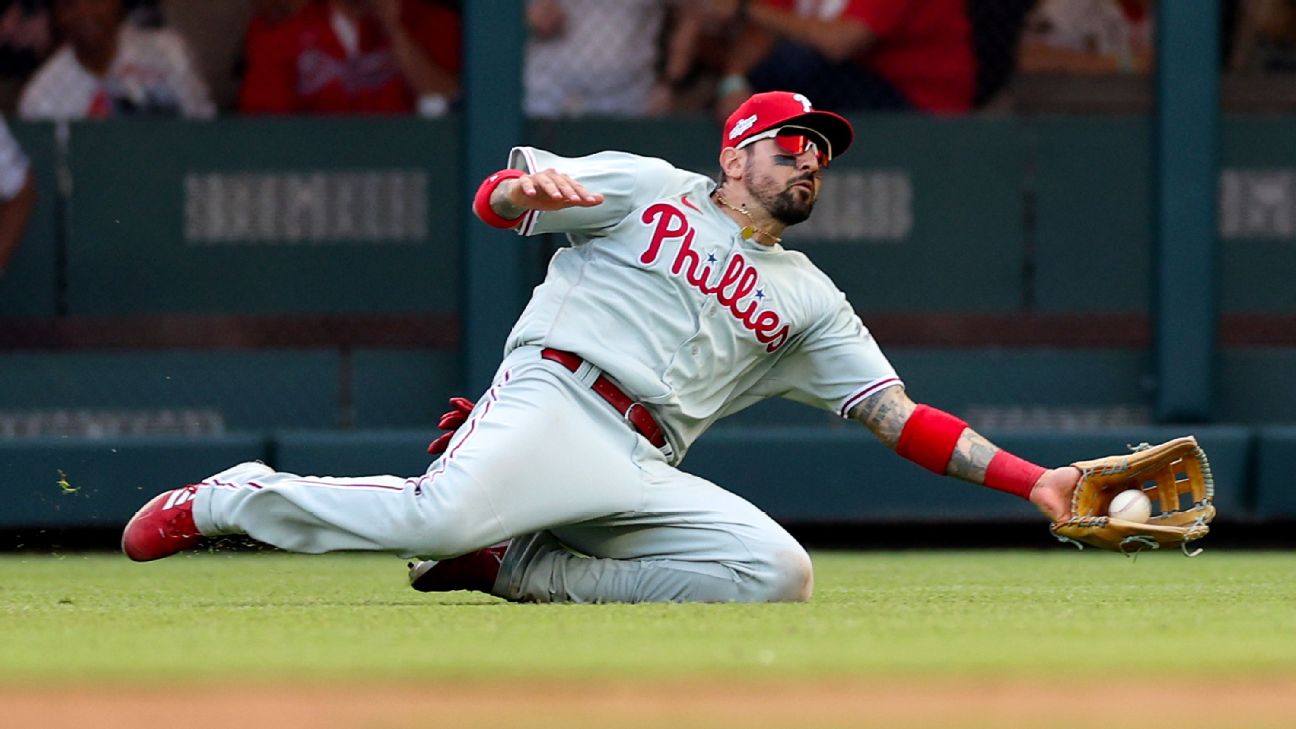
In the top of the 10th, Phillies catcher J.T. Realmuto led off with a home run. It’s fun to hear the broadcast calls in Spanish, French, Russian and Japanese (click here – 2:20).
Houston did not score in its half of the 10th, and the Phillies won 6-5.
In postseason history, when a team had led by five or more runs, the teams with the early leads were 589-16. After this game, the record was 589-17.
Game 2 – Astros Win 5-2: In last year’s World Series, Houston’s Framber Valdez started two games against the Braves. It did not go well. As described by the NYT’s Tyler Kepner, Valdez “was flattened twice in the World Series with an earned run average evocative of a crash: 19.29.”
But not in 2022. Valdez pitched into the 7th and gave up only one run. Phillies ace Zach Wheeler was not so lucky. The first three batters he faced hit doubles. Took only four pitches. Add in some bad defense, and the Astros were up 3-0. Alex Bregman added a 2-run homer in the 5th, and the Astros lead was 5-0, just like it had been in Game 1. But no Phillies comeback this time.
The Phillies scratched out two runs and came close to two more when Kyle Schwarber teased everyone by hitting back-to-back pitches for 756 feet. One was a barely-foul ball (403’), and the other was a blast caught at the wall (353’). Final score 5-2 in favor of the Astros.
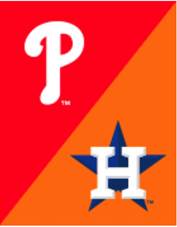
Next, a day off for travel as the Series moved from Minute Maid Park to Citizens Bank Park.
Scheduled Game 3: Happy Halloween. Philadelphia fans without tickets could head to the bars on South Street to watch the game.
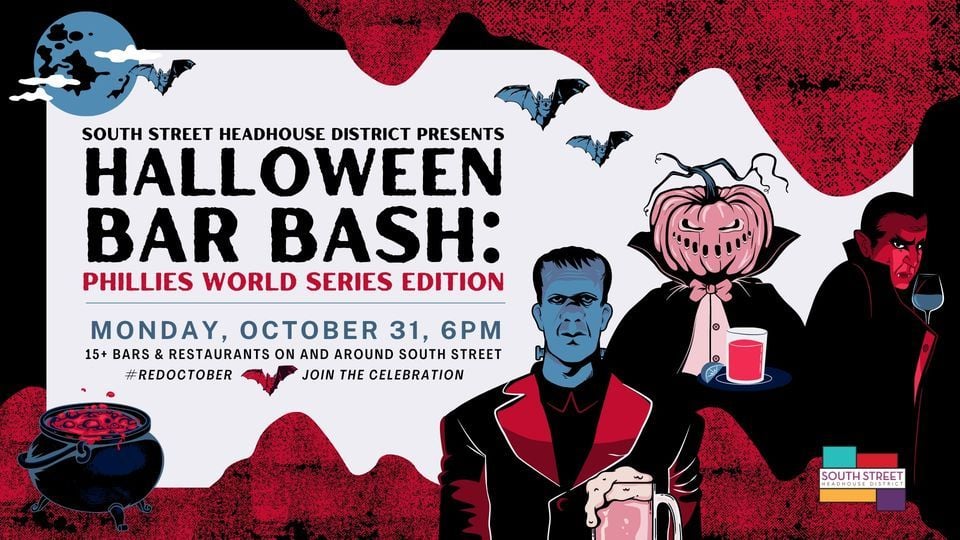
The announced starter for the Phillies sounded like a Halloween character – Thor. Royals fans will remember Thor (a/k/a Noah Syndergaard) as the menacing Mets rookie pitcher who started Game 3 of the 2015 World Series. The first batter he faced was Alcides Escobar who had been proficient at getting a hit on the first pitch during the postseason. Thor remedied that by throwing his first pitch just above Escobar’s head. Then struck him out. Thor won the game and said if the Royals had a problem with inside pitches, they could meet him on the mound 60-feet, 6-inches away. After the Royals won the World Series trophy, one pundit suggested that Thor could meet the trophy 1,207 miles away. With hindsight, I was glad the Royals lost Game 3 because it extended the Series to five games. Remember Game 5? Hosmer’s slide, etc. Sweet.
Okay, back to 2022. Plagued by injuries over the years, Syndergaard has not been the star he was in his early Mets days. He had pitched only five innings in the postseason and did not carry a heavy workload down the stretch. But he was needed because the regular starters needed rest.
And then the rains came. That gave a day of extra rest. Thor was no longer needed to start Game 3.

Game 3 – Phillies Win 7-0: It’s November 1. For the first time, more World Series games will be played in November than in October. More games were pushed into November because the lockout delayed the opening of the season.
[November 1 Royals Trivia: On this date in 2015, the Royals won the World Series over the Mets. Click here.]
Jose Altuve opened the game with a looper to right, and in a bit of déjà vu from Game 1, Nick Castellanos made a diving catch. It was a good omen.
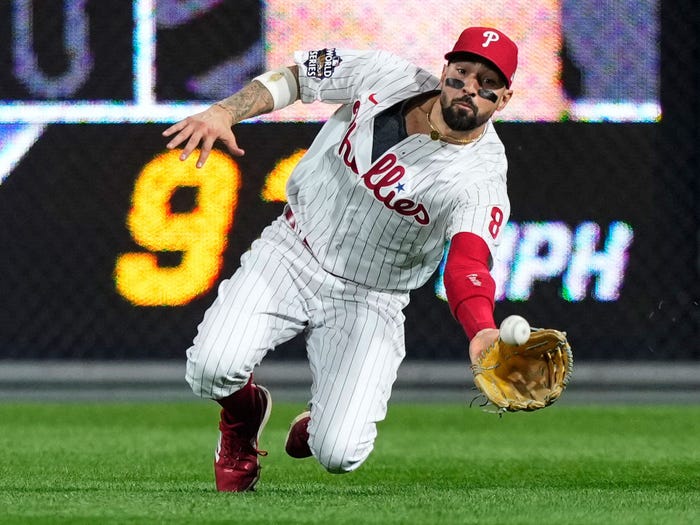

A rested Ranger Suarez was on the mound for the Phillies. He pitched five shutout innings, and was followed by relievers who also gave up no runs.
A rested Lance McCullers was on the mound for the Astros. He gave up five home runs in five innings. A new World Series record for one pitcher, although manager Dusty Baker deserves some credit for the record – he left McCullers in too long, just as he had done with Verlander in Game 1. There was some thought that McCullers was tipping his pitches, but he said he just had a bad night. Same result under either version. Phillies won 7-0.
[World Series Home Run Trivia: When the game started, there had been 998 home runs hit in the World Series. The new count, courtesy of the Phillies, goes like this: Bryce Harper (999), Alex Bohm (1,000), Brandon Marsh (1,001), Kyle Schwarber (1,002) and Rhys Hoskins (1,003).]
Game 4 – Astros Win 5-0: Déjà vu. The Astros took a 5-0 lead, just like they had in Games 1 and 2. The Phillies did not even threaten a comeback – they got no hits. Starter Cristian Javier and three relievers combined for a no-hitter, the second in World Series history.
Bruce Springsteen was there.

Javier pitched the first six innings and the relievers pitched one inning each, a combined total of 141 pitches. The only other no-hitter was thrown by the Yankees Don Larsen (by himself) in 1956 – a perfect game in which Larsen threw 97 pitches. Javier threw 97 pitches in his six innings. Baseball evolution.
I enjoyed watching this slice of baseball history, but combined no-hitters are not high on my list of big events. Baseball fans still talk about Don Larsen after 66 years, but I’m betting only Astros fans will remember the names of the four pitchers who threw the 2022 no-hitter. I will give a shout-out to Christian Vazquez, the Astros catcher who played the full nine innings. He and Yogi Berra are the only two catchers who have caught a World Series no-hitter.
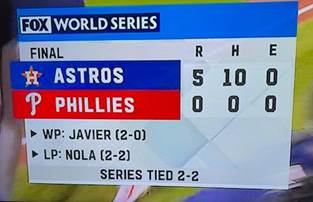
On this date (November 3) in 2015…
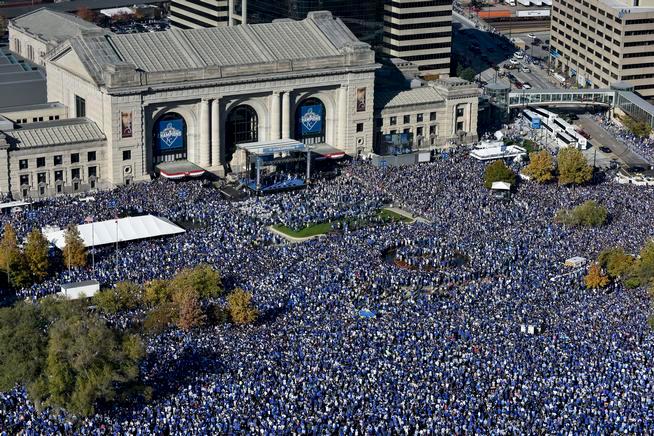
Game 5 – Astros Win 3-2: Big sports night for Philadelphia and Houston. The Eagles beat the Texans at NRG Stadium in Houston. The Astros beat the Phillies at Citizens Bank Park in Philadelphia. I would have preferred the opposite result in both games. The two games represented one-half of another “Sports Equinox” (NFL, MLB, NHL and NBA all playing on the same night).
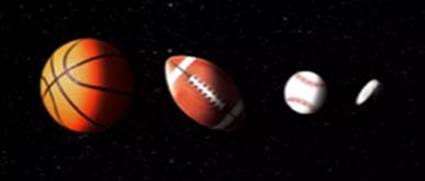
The Phillies starter was Thor (Noah Syndergaard) who was bumped to Game 5 after the Halloween rainout. The Astros starter was Justin Verlander who has three career no-hitters (all by himself), but no World Series victories after eight starts. Will #9 be the charm?
Yes it will. Verlander won, but not with ease. The first batter he faced, Kyle Schwarber, hit a home run. Verlander then gave up four more hits plus four walks through his five innings, but left the game with a 2-1 lead. Thor lasted only 3+ innings and took the loss.
The game was full of missed opportunities. Runners were constantly on base, but hitters could not keep the line moving. The key stat: With runners in scoring position, Houston was 1-11 and Philadelphia was 1-7. In all, there were 24 strikeouts and 19 runners left stranded.
Each team scratched out a run in the 8th to make it 3-2. In the bottom of the 9th, the Phillies had three sluggers coming up. The Astros reliever was Ryan Pressly. Rhys Hoskins struck out. J. T. Realmuto hit a blast to right center that looked like a sure double. In center field was Chas McCormick, a native of suburban Philadelphia who grew up a Phillies fan. But not a fan on this night. Running a perfect route and timing his leap, McCormick made the highlight fielding play of the Series:
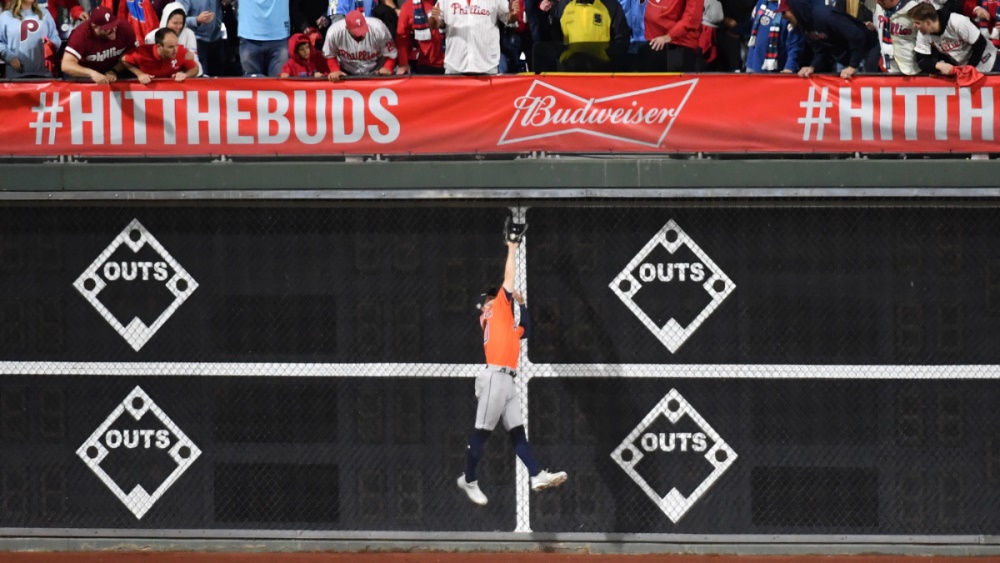
The photo does not do justice to the catch and proximity to the wall, so be sure to watch the video here. The Philadelphia Eagles had finished their NFL win in Houston and were watching the play in the locker room. They were hoping for a different result (click here).
After banging against the wall, McCormick laid on the warning track and held the ball aloft…
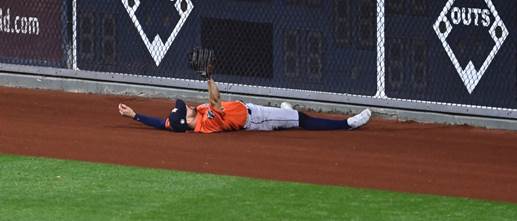
And the grateful pitcher enjoyed the moment…

While the frustrated batter headed to the dugout…

Midnight (EDT) was approaching and there were two outs. Glass slipper or pumpkin? Bryce Harper up. Hit by a Pressly pitch. Next, Nick Castellanos. Grounded out. Game over, 3-2. Pumpkin.
The Phillies, rabidly supported by their home fans, won only one of three games at Citizens Bank Park. Next stop for the Phillies, Minute Maid Park in Houston, to see if they could find that glass slipper and be the Cinderella of 2022.
Game Six – Astros Win 4-1: No Cinderella. Astros starter Framber Valdez repeated his Game 2 success – this time going six innings and allowing one run. Three relievers followed and shut down the Phillies.
Zach Wheeler of the Phillies kept a pitching duel going for five innings and had a lead of 1-0 in the sixth. But he found himself with two pesky Astros on base, Jose Altuve and Jeremy Pena who had been in the middle of most of the Astros rallies. The Phillies changed pitchers, putting Jose Alvarado on the mound to face Yordan Alvarez. Then, just as he had done in the first two games of the ALDS against Seattle, Alvarez put Houston in the lead by blasting a no-doubter home run. New score, 3-1.

The Astros tacked on another run in the 6th. The Phillies bats remained silent. Final score, 4-1. Astros win the World Series, four games to two.
Analysis: Good pitching beats good hitting. The Phillies hit .163, a record low for a World Series of at least six games. They struck out 71 times, a record World Series high. The ERA for the Astros pitchers against the vaunted Phillies sluggers was 2.83 (just below their MLB-leading season ERA of 2.90).
The hitting star for the Astros was rookie Jeremy Pena who hit .400 and won the Willie Mays MVP trophy (below). He was also the MVP of the ALCS. I’ll say it again – a rookie.
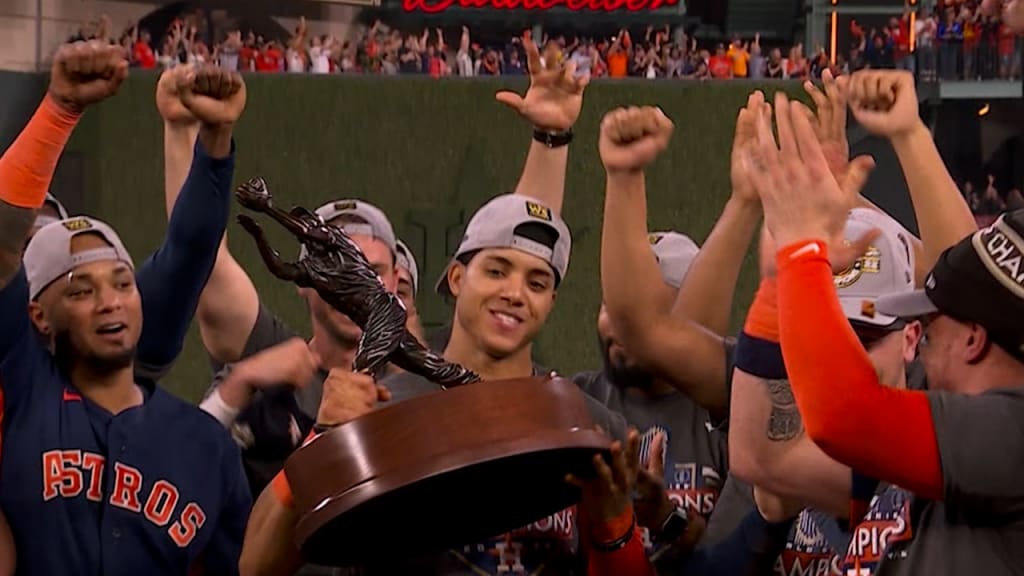
Looking Ahead: I’m intrigued by what the new rules will mean for 2023. Bigger bases. Limitations on fielding shifts. The pitch clock.
During the series, every time I saw a liner to right field end up in the glove of the shifted second baseman, I had warm thoughts of more offense next year.
And the slowness of the games with pitchers fidgeting and batters stepping out. I nodded approvingly when Joe Posnanski tweeted this during Game 4:

As for the offseason (a/k/a Hot Stove season), there will still be Hot Stove posts, but with bigger breaks in the action. It’s not long until spring training. Check out the second # below.

Lonnie’s Jukebox – Philadelphia’s American Bandstand: In Hot Stove #208, Lonnie’s Jukebox featured the “Philadelphia Sound” from the 1970s (“Love Train,” etc.). This prompted an email from reader Nick Ventola who suggested a 1960s Philadelphia song to play if the Phillies won the World Series. The Phillies lost, but I can’t resist playing the infectious song.
Nick’s song is “South Street” by the Orlons, and it celebrates an area in South Philly that to this day is known for its melting pot population and cool places to go – or as the Orlons sing…
Where do all the hippest meet? (South Street, South Street)
Where the dancin’ is elite (South Street, South Street)
Side by side were loose and neat
When we’re stompin’ down the street
Hurry down, baby she’s the hippest street in town! (Oh baby)
When I looked for a link to the song, I kept running into a Philadelphia institution, Dick Clark’s American Bandstand. So I’ll play Nick’s song and then expand to other Dick Clark selections.
“South Street” by the Orlons, as played on and danced to on American Bandstand. The record peaked at #3 in 1963. The Orlons were a Philadelphia-based doo-wop group, and this was one of their five Top-20 hits.
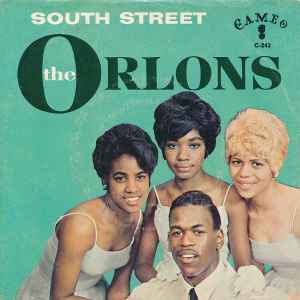
In 1956, Dick Clark became the permanent host of the local Philadelphia show Bandstand. He took it national in 1957, renaming it American Bandstand. The format featured dancing teenagers and appearances by recording acts who usually lip-synced their lyrics. Clark assumed the audience wanted the popular recorded version. As recounted in last week’s Hot Stove, an exception to lip-syncing was Jerry Lee Lewis who said “I ain’t no puppet! I didn’t come all the way up from Memphis to play charades.”
Local record labels were major beneficiaries of American Bandstand because their acts were readily available to appear on the show. Chancellor Records had Frankie Avalon and Fabian. The biggest roster was at Cameo-Parkway whose acts included Chubby Checker, Bobby Rydell, the Orlons, the Rays and Dee Dee Sharp. From the late ‘50s to 1963, Cameo-Parkway produced many Top-10 records – five reaching #1, including…
“So Much in Love” by the Tymes (1963).
Then suddenly, on back-to-back days, the Philadelphia magic was gone. On February 8, 1964, American Bandstand moved to Los Angeles. The next day, the Beatles made their first appearance on the Ed Sullivan Show. The music world changed overnight. A few months later, the Supremes and Temptations of Motown started releasing hit after hit out of Detroit. The local Philadelphia labels and most of their artists soon faded from the charts.
On a personal level, the early Philadelphia years of American Bandstand coincided with my high school years. It was great to see the new rock ‘n’ roll acts on the shows, and Dick Clark was good at marketing with his own compilation albums. I have his first two, released in 1957 and 1958. I’ve picked three from each album, and some of the links will be of appearances on American Bandstand. Beware: Blatant lip-syncing.
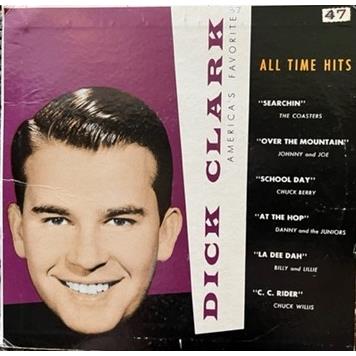
“Searchin’” by the Coasters (1957). Peaked at #3. Group had six Top-10 hits, all written by the legendary duo of Leiber and Stoller.
“Over the Mountain” by Johnnie and Joe (1957). #8. One-hit wonder.
“School Day” by Chuck Berry (1957). #3. Many-hit wonder.
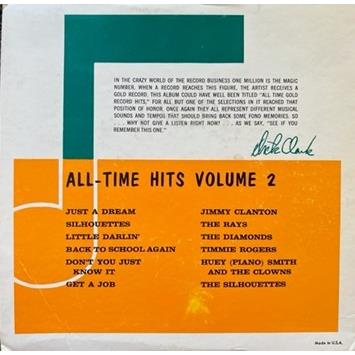
“Silhouettes” by the Rays (1957). #3. Only Top-40 hit.
“Little Darlin’” by the Diamonds (1957). #3. Two other Top-10 hits: A cover of the Rays’ “Silhouettes” (#10) and a record that started a dance craze, “The Stroll” (#4).
“Get a Job” by the Silhouettes, the group, not the song (1958). #1. One-hit wonder.

The biggest hit fostered by American Bandstand was Chubby Checker’s “The Twist.” The song had been a moderate hit for Hank Ballard and the Midnighters, and Dick Clark suggested that Cameo-Parkway record a cover version. The artist selected was a local Philadelphia singer, 18-year-old Ernest “Chubby” Evans. When Chubby showed up at the recording session, Dick Clark’s wife suggested that the singer use the stage name of Chubby Checker, a play on Fats Domino’s name. It stuck.
Promoted with many appearances by Chubby Checker on American Bandstand, the record shot to #1. It came back to the charts in 1961/62 and again rose to #1. One of the biggest selling records of all time.
“The Twist” by Chubby Checker (1960). Below, Chubby teaching Dick Clark the dance moves.
